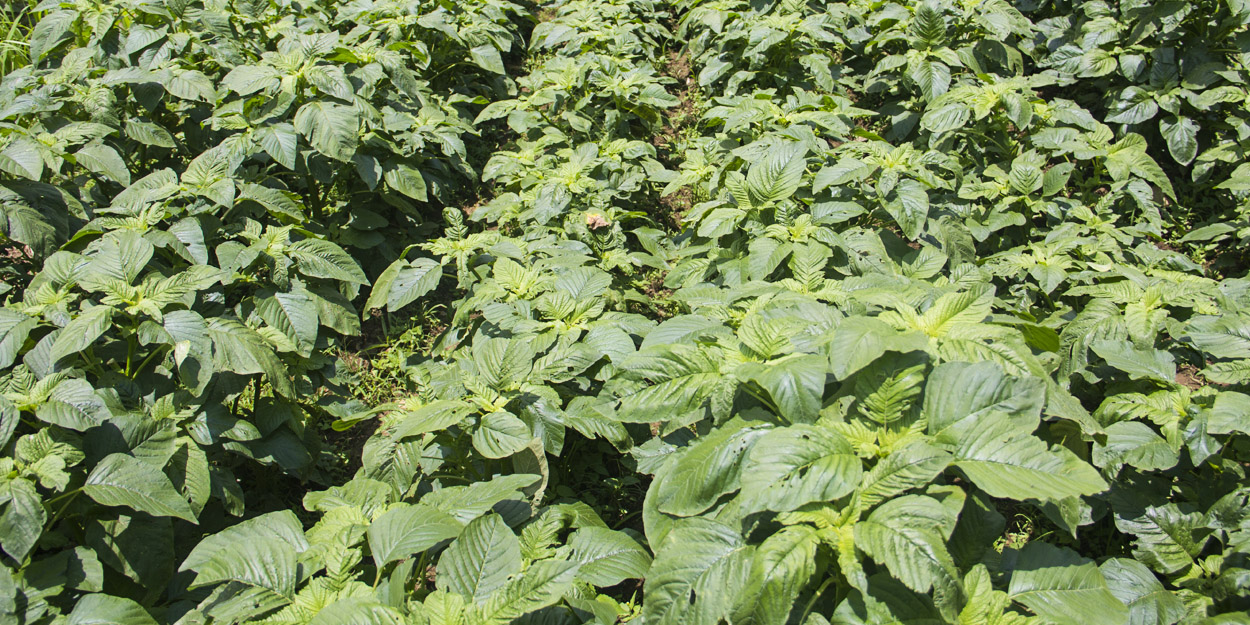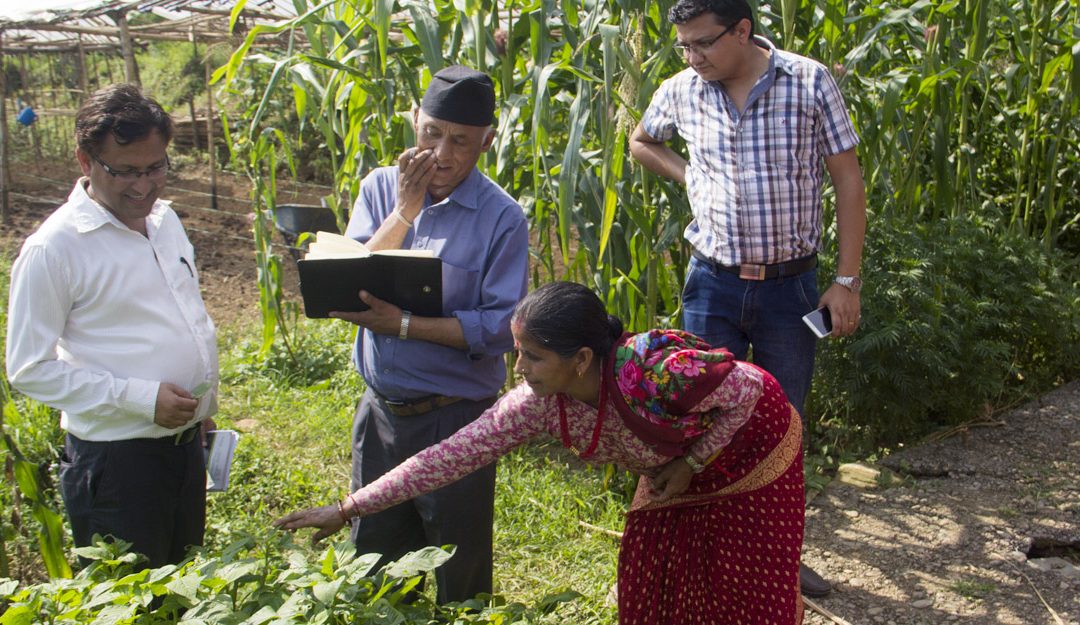On 11th June 2017, LI-BIRD, in coordination with Seed Quality Control Centre (SQCC), organized a field visit programme for the team of Variety Release and Registration Committee (VRRC). The programme was organized to share the finding of the research on Amaranth crop and proceed ahead for the varietal registration process of the identified genotype. The VRRC team is comprised of Deputy Director General of Department of Agriculture (DoA), Chief and Senior Seed Officer from SQCC, Director of Crops and Horticulture-NARC, Chief of Crop and Horticulture Division- NARC, Chief of Seed Science Technology Division, Senior Scientist of Soil Science Division, Program Director of Vegetable Development Directorate-DoA, representative from Seed Entrepreneurs’ Association of Nepal – SEAN and NGO representative from Center for Environment and Agricultural Policy Research, Extension and Development (CEAPRED), Regional Agriculture Director of Western Region, Senior Agriculture Development Officer from DADO Kaski, Chief of horticulture research station Malepatan, and representative from Regional Agricultural Research Station (RARS), Lumle. The farmer representatives from Arba also joined the VRRC team in the visit programme.
Amaranth is considered as one of the ancient crops grown especially in South America, Asia and Africa, and believed to be originated from Central and South America. It is a nutritious crop with rich in crude calcium, iron, magnesium, potassium and zinc crude fiber, Vitamin C, B6 and A. In Nepal, the crop is consumed as grain in Karnali and high hills, and green vegetables in mid hills and Terai. However, the farming community rarely uses amaranth for intentional cultivation as green vegetables. The situation is aggravated due to less attention provided by the researchers towards amaranth.

Amaranth is a nutritious crop with potentiality for supplying green leafy vegetable during scarce seasons in Nepal. Photo: Chandra Gurung, LI-BIRD.
Realizing the importance of Amaranth, LI-BIRD with support of International Fund for Agricultural Development (IFAD) funded NUS and UNEP/GEF funded Local Crop Project (LCP) carried out research on amaranth crop from 2012 to 2016. A total of 435 genotypes collected across Nepal were evaluated in collaboration with HCRP and NAGRC. The main objective of research was to study the diversity of amaranth available in Nepal while specific objectives were to identify and promote genotypes for grain and leafy vegetable use.
In the programme, Mr. Rajeev Dhakal, the plant breeder from LI-BIRD, presented the result of evaluation of genotypes at different locations and highlighted that the performance of genotype collected from Ramechhap (# 254/ NGRC-06990) are the best in leaf yield and acceptance. The characteristics of selected amaranth genotype #254 are smooth green leaves, soft and tender, easy to cook and has good taste which has made it the most potential genotype among evaluated and is identified for registration. This particular genotype has potentiality for supplying green leafy vegetable during scarce seasons (March-May). Furthermore, Mr. Tek Nath Baral, a farmer from Namuna Organic Agriculture Cooperative in Arba who was also engaged during evaluation, highlighted that the proposed variety has better eating and cooking qualities than other commonly found amaranths in locality. He added that the physical appearance resembles with other green leafy vegetables making the proposed variety competitive in market.

Plant breeder explaining the characterstics of the proposed variety. Photo: Santosh Rasaily, LI-BIRD.
After the presentation, the multidisciplinary expert team of VRRC visited amaranth demonstration plots located at Gairapatan, Pokhara, which is managed by LI-BIRD. Three different genotypes were allocated in three replications. After observation, everyone appreciated and agreed about the potentiality of proposed genotype to be registered, and mainstreaming it in national system for its scaling up. Some of the members also recommended to register another genotype (#245), along with genotype #254, which has red pigmentation in its stem and petioles and, is equally good in leaf production. The team visited farmers’ field in Begnas and interacted with them. It was good to learn that intentional cultivation of Amaranth has now been initiated. Farmers are increasingly aware about the commercial and nutritional values of the crop. So far, it has been utilized mainly for home consumption. However, few hotels have started preparing vegetables of amaranth in Begnas for guests too.
During lunch, the participants were served with vegetable prepared from proposed variety and all of them appreciated the taste, its soft texture and colour. A hotel owner in Sundaridada, Surya Lamichhane said, “We had never cultivated amaranth intentionally until LI-BIRD provided us with the seeds three years back. We have been cultivating amaranth since then, and use for both home consumption and for our three hotels. The green type (proposed genotype) is very much useful for us to serve as green leafy vegetable to visitors and tourists in our hotels since the variety supply during lean period and no other green leafy vegetable is available in market.”
In the reflection session organized at Information Center in Sundaridada, Mr. Dharma Dutta Baral, Chief of SQCC recommended, “It is a local variety and our national property. So, we are very positive about the variety and it can be easily registered in our system.” Similarly, Dr. Yagya Prasad Giri, Crop and Horticulture Director – NARC, suggested to include cost benefit analysis of the proposed variety with other competing leafy vegetables. The VRRC team urged LI-BIRD to proceed for submitting the proposal as early as possible.

Participants at the amaranth demonstration plot located at Gairapatan, Pokhara. Photo: Bibudh Dhewaju, LI-BIRD
Concluding the visit by thanking participants, Dr. Balaram Thapa, Executive Director of LI-BIRD, said, “The feedbacks provided from the participants are very useful. LI-BIRD team will consider them and compile the available information and submit proposal very soon.” He further added, “LI-BIRD will be responsible for maintenance of the variety. We also seek for coordination and support from all the related stakeholders including private sector for promotion of the variety”.
For research and promotion of neglected and underutilized crops like Amaranth, collaboration among government, non-government and private sector stakeholders is necessary. To formalize, mainstream and commercialize such important but underutilized crops, varietal registration is the initial stepping step. Thus, varietal registration of proposed variety will open new avenues for its promotion and commercialization of its seed and, also, leafy vegetables as a product. Additionally, collaboration with private sector is essential for production and marketing of quality seeds of the variety so that it can be accessible to the farmers. The research work on Amaranth and promotion of selected genotype through registration and linking with national seed system is believed to be a milestone in conservation and utilization of nutritious neglected crops which is also considered as a future smart crop
This article is jointly prepared by team comprising Bharat Bhandari, Bibudh Dhewaju, Rajeev Dhakal, Rita Gurung and Santosh Rasaily.
